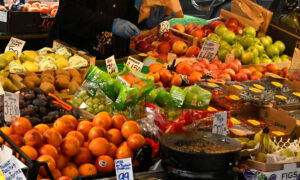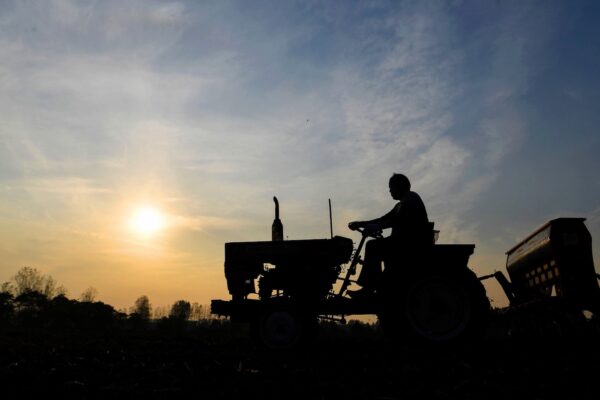World Food Prices Rise for First Time in a Year: FAO
The world price index of the United Nations food agency increased in April this year for the first time since April 2022, but it is still 20 percent lower than a March 2022 peak after the war in Ukraine started. The Food and Agriculture Organization’s (FAO) price index, which tracks the most globally traded food commodities, averaged 127.2 points last month against 126.5 points for March, the agency said on Friday. The March reading was originally given as 126.9 points. The agency said it reflects higher prices of rice, meat, and sugar. Declines were observed in the cereals, dairy, and vegetable oil price indices. “As economies recover from significant slowdowns, demand will increase, exerting upward pressure on food prices,” said FAO Chief Economist Maximo Torero. The sugar price index increased 17.6 percent from March, reaching its highest point since October 2011. This was due to concerns about tight supplies from India and China and lower-than-expected outputs in Thailand and the European Union, according to FAO. While the meat index rose 1.3 percent month-on-month, dairy prices dipped 1.7 percent, vegetable oil prices fell 1.3 percent, and the cereal price index shed 1.7 percent, with a decline in world prices of all major grains outweighing an increase in rice prices. “The increase in rice prices is extremely worrisome, and it is essential that the Black Sea initiative is renewed to avoid any other spikes in wheat and maize,” said Torero, referring to a deal to allow the export of Ukrainian grain via the Black Sea. “[The] 2023/24 prospects for rice production along and south of the equator are mixed, largely due to the regionally varied impact of the La Niña event,” FAO also said. Black Sea Grain Deal On Friday, Ukraine, Russia, Turkey, and the United Nations failed to authorize any new ships under a deal allowing safe Black Sea exports of Ukraine grain. Daily inspections of previously authorized ships continue, deputy U.N. spokesperson Farhan Haq told reporters. Officials from the four parties make up a Joint Coordination Centre (JCC) in Istanbul, which implements the Black Sea deal agreed in July. Ukraine has been putting forward daily a list of ships to be authorized. Once approved, those ships are then inspected by the JCC officials near Turkey before traveling to a Ukrainian Black Sea port via a maritime humanitarian corridor to collect their cargo and return to Turkish waters for a final inspection. According to JCC data, there is currently one ship authorized for inbound inspection and 25 ships awaiting an outbound inspection—all in Turkish waters; there are 13 ships in Ukrainian ports, and there are five ships in transit toward Ukraine and two vessels in transit heading back to Turkey. There are eight vessels seeking authorization from the JCC, according to the Ukrainian sea ports website. Russia’s foreign ministry said on April 27 that only a full implementation of the Black Sea grain deal could save the deal from collapse, reaffirming Moscow’s dissatisfaction with an accord that aims to prevent a global food crisis. Russia has repeatedly said it will not allow the deal to be extended beyond May 18 unless the West removes obstacles to Russian grain and fertilizer exports. “[The deal] is not a buffet you can pick and choose from,” Russian foreign ministry spokeswoman Maria Zakharova told a regular news conference in Moscow, adding that implementation of the deal so far had been unsatisfactory. Although Russia’s agricultural exports have not been explicitly targeted by Western sanctions, Moscow says restrictions on its payments, logistics, and insurance industries—imposed over its military actions in Ukraine—have created a barrier to the export of its grains and fertilizers. One of Russia’s main demands in negotiations is the reconnection of the Russian Agricultural Bank (Rosselkhozbank) to the SWIFT payments system. Export Grain Remains in Transit Countries On April 18, Polish and Ukrainian officials said convoys of Ukrainian grain transiting Poland for export abroad would be sealed, guarded, and monitored to ensure the produce stops flooding the Polish market and playing havoc with prices. The announcement came after two days of intensive talks following protests by Polish farmers, who said much of the Ukrainian grain was staying in Poland and creating a glut that caused them huge losses. Polish Agriculture Minister Robert Telus told a press conference that day that Warsaw and Kyiv “have worked out mechanisms that mean that not a single ton of [Ukraine] grain will remain in Poland, that it will all be passing in transit.” After Russia blocked traditional export sea passages amid the war in Ukraine, the European Union lifted duties on Ukrainian grain to facilitate its transport to Africa and the Middle East and offered to pay some compensation, which the farmers said was insufficient. Much of the grain ends up staying in transit countries, and some Polish unions and op

The world price index of the United Nations food agency increased in April this year for the first time since April 2022, but it is still 20 percent lower than a March 2022 peak after the war in Ukraine started.
The Food and Agriculture Organization’s (FAO) price index, which tracks the most globally traded food commodities, averaged 127.2 points last month against 126.5 points for March, the agency said on Friday. The March reading was originally given as 126.9 points.
The agency said it reflects higher prices of rice, meat, and sugar. Declines were observed in the cereals, dairy, and vegetable oil price indices.
“As economies recover from significant slowdowns, demand will increase, exerting upward pressure on food prices,” said FAO Chief Economist Maximo Torero.
The sugar price index increased 17.6 percent from March, reaching its highest point since October 2011.
This was due to concerns about tight supplies from India and China and lower-than-expected outputs in Thailand and the European Union, according to FAO.
While the meat index rose 1.3 percent month-on-month, dairy prices dipped 1.7 percent, vegetable oil prices fell 1.3 percent, and the cereal price index shed 1.7 percent, with a decline in world prices of all major grains outweighing an increase in rice prices.
“The increase in rice prices is extremely worrisome, and it is essential that the Black Sea initiative is renewed to avoid any other spikes in wheat and maize,” said Torero, referring to a deal to allow the export of Ukrainian grain via the Black Sea.
“[The] 2023/24 prospects for rice production along and south of the equator are mixed, largely due to the regionally varied impact of the La Niña event,” FAO also said.
Black Sea Grain Deal
On Friday, Ukraine, Russia, Turkey, and the United Nations failed to authorize any new ships under a deal allowing safe Black Sea exports of Ukraine grain.
Daily inspections of previously authorized ships continue, deputy U.N. spokesperson Farhan Haq told reporters. Officials from the four parties make up a Joint Coordination Centre (JCC) in Istanbul, which implements the Black Sea deal agreed in July.
Ukraine has been putting forward daily a list of ships to be authorized. Once approved, those ships are then inspected by the JCC officials near Turkey before traveling to a Ukrainian Black Sea port via a maritime humanitarian corridor to collect their cargo and return to Turkish waters for a final inspection.
According to JCC data, there is currently one ship authorized for inbound inspection and 25 ships awaiting an outbound inspection—all in Turkish waters; there are 13 ships in Ukrainian ports, and there are five ships in transit toward Ukraine and two vessels in transit heading back to Turkey.
There are eight vessels seeking authorization from the JCC, according to the Ukrainian sea ports website.
Russia’s foreign ministry said on April 27 that only a full implementation of the Black Sea grain deal could save the deal from collapse, reaffirming Moscow’s dissatisfaction with an accord that aims to prevent a global food crisis.
Russia has repeatedly said it will not allow the deal to be extended beyond May 18 unless the West removes obstacles to Russian grain and fertilizer exports.
“[The deal] is not a buffet you can pick and choose from,” Russian foreign ministry spokeswoman Maria Zakharova told a regular news conference in Moscow, adding that implementation of the deal so far had been unsatisfactory.
Although Russia’s agricultural exports have not been explicitly targeted by Western sanctions, Moscow says restrictions on its payments, logistics, and insurance industries—imposed over its military actions in Ukraine—have created a barrier to the export of its grains and fertilizers.
One of Russia’s main demands in negotiations is the reconnection of the Russian Agricultural Bank (Rosselkhozbank) to the SWIFT payments system.
Export Grain Remains in Transit Countries
On April 18, Polish and Ukrainian officials said convoys of Ukrainian grain transiting Poland for export abroad would be sealed, guarded, and monitored to ensure the produce stops flooding the Polish market and playing havoc with prices.
The announcement came after two days of intensive talks following protests by Polish farmers, who said much of the Ukrainian grain was staying in Poland and creating a glut that caused them huge losses.
Polish Agriculture Minister Robert Telus told a press conference that day that Warsaw and Kyiv “have worked out mechanisms that mean that not a single ton of [Ukraine] grain will remain in Poland, that it will all be passing in transit.”
After Russia blocked traditional export sea passages amid the war in Ukraine, the European Union lifted duties on Ukrainian grain to facilitate its transport to Africa and the Middle East and offered to pay some compensation, which the farmers said was insufficient.
Much of the grain ends up staying in transit countries, and some Polish unions and opposition politicians accuse government-linked companies of causing the problem by buying up cheap, low-quality Ukrainian grain and then selling it to bread and pasta plants as high-quality Polish produce.
China’s Production Remains Low
China’s rural grain yields are still low, and land rents and labor prices remain high. Meanwhile, food production costs continue to increase due to the impact of rising international energy and fertilizer prices.

According to a research report by China Agricultural University published in July of 2022, the average net profit of China’s three major grains, rice, wheat, and corn, for 2020 was $6.8 per 0.165 acres.
The average net profit increased from $28.6 per 0.165 acres in 2004 to $36.5 per 0.165 acres in 2011.
From 2016 to 2019, the average net profits of the three main grains were all negative.
In 2020, affected by the COVID-19 pandemic and other factors, grain prices rose rapidly, and the average net profit of China’s three main grains recovered to $6.8 per 0.165 acres.
The boost was only temporary, however, and soaring costs since that time have heavily impacted farming returns.
According to the report, from 2004 to 2020, the average input costs of seeds, fertilizers, and pesticides for China’s three main grains increased by 1.35 times. Land and labor costs increased even more, by 3.42 times and by 1.92 times respectively, and mechanical operation costs increased by 3.88 times to 13.8 percent of total costs in 2020. Drainage and irrigation fees also increased. All of these factors contributed to the squeezing of farmers’ profits.
Planting costs have soared, making it unprofitable for small farmers to farm. Small farmers make up the main body of rural production in China.
Anne Zhang, Reuters, and The Associated Press contributed to this report.












